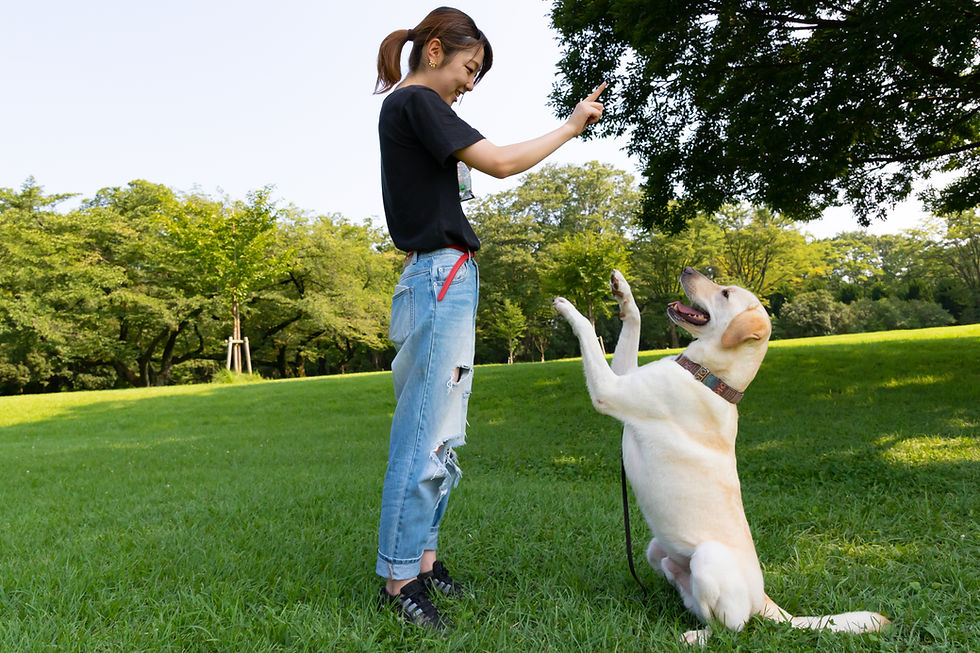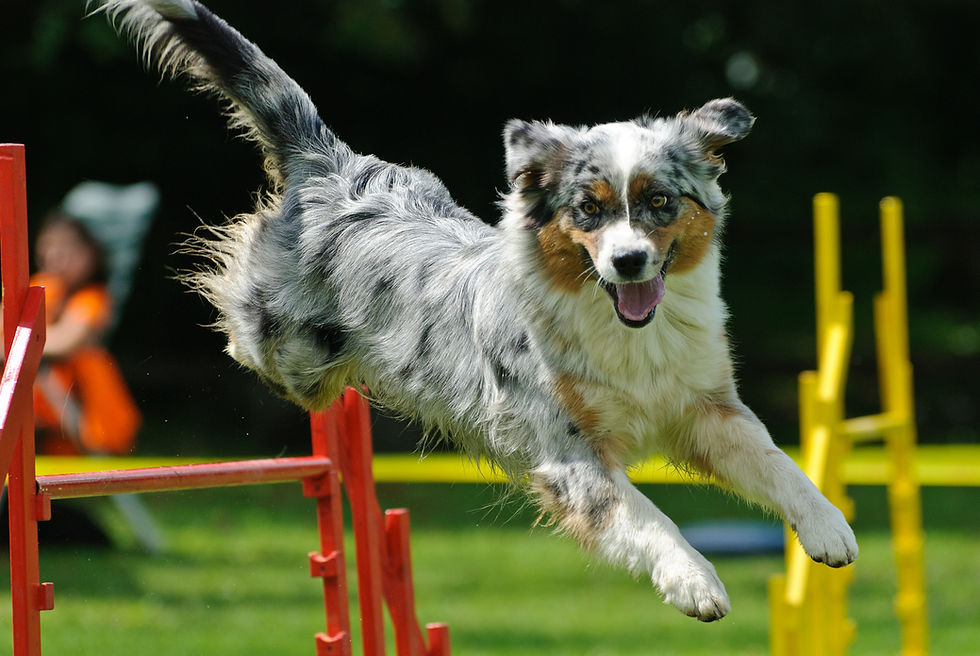Steps in Dog Training: Basics
- stephanie pope

- Apr 26, 2022
- 7 min read
Updated: May 20

Puppy training and socialization are among the most basic needs of your pets. If you are going to train a dog for the first time, this experience can be a little overwhelming for you. Training your dog can also be a tiresome process, especially if you are a new pet parent and have a job. However, we will provide you with information about Steps in Dog Training: Basics. Follow these simple steps to train your puppy efficiently.
Steps for Dog Training:
You can follow these simple steps to train your new dogs or puppies to follow your commands.
Start with the Basics
You must start acclimatizing your dog with love and patience for the initial training. The training process must start with the basic commands. You can take help from an obedience program if you are completely inexperienced. Dog obedience programs build the foundation of the relationship between you and your pet. Your dog learns to recognize your sound and commands and learn to apply them slowly.
Use Games to Train
Training must be a fun experience for both you and your pets. Dogs are very active and highly cognitive creatures. They learn new skills easily. So, you can make your pet play ball fetching with you. You can easily teach them the basic commands using games.

The basic commands of dog training include sit, come, down, stay and leave it. Several games can strengthen the bond between you and your pet. These games include tug of war, following the prey, hide, and seek, fetching the ball, etc. Choose any game you like to play with your dog, keeping in mind the physical condition and interest of your pet.

Provide Positive Reinforcement
Every organism seeks appreciation for its achievements. The best way to improve obedience is to provide positive reinforcements in dog training as appreciation. This appreciation can be verbal, or it can be as treats that you can provide to your pets. Dogs struggle a lot to make a good bond with their owners, so if your dog is a slow learner, try to keep a low pace for better bonding.
Don't Rush the Process
Every dog has a different nature. Some dogs are more active and friendly than others. They take lesser time to grasp things. However, other dogs are shy and take more time to open up with their new owners. You must understand the nature of your pet before you train them.
If your dog is shy, do not force it to socialize and play. Let it acclimatize to the new environment. Do not rush the process of training, as it can make your dog stubborn and aggressive.

Socialization is Key
Socialization is the best way to deal with behavioral problems in dogs. Some dogs become anxious around people. Some of them fear traveling and walking around in public. The best way to train your pet is to take him out for a walk. Doing fun activities together will help you bond with your pet. Socialization also teaches your pet how to behave in public.
It's also a great to have them socialize with other dogs. Sometimes the mature dogs in the play groups can teach the younger ones what is good or bad behavior. Dogs are pack animals and love to socialize with other dogs. Teaching your dog that other dogs are okay to play with will boost their confidence. They will also blossom into their own personalities.
Types of Dog Training
We mainly divided dog training into two types. One is the basic level training. In this training, the dog learns to understand the commands of its owner. This training includes basic commands like sit, stay, run, etc. However, in advanced level training, the dogs learn to perform different activities. Such as the Police hounds learn to smell and differentiate distinct scents. Similarly, there are companion dogs for patients with psychological problems like epilepsy or dementia.
Following is the training you can provide to your dogs.
House Training
House training is essential training for pets so that they eliminate their waste in your presence and you can manage it in a better way. Many dogs are shy. They are more likely to eliminate their waste in a desolate area. However, it is not necessarily difficult to train your puppies for this purpose. You can take your puppy outside and allow them to urinate or defecate once you return home. In this way, they will eventually become habitual of urinating after they return home.

Potty Training
All carnivores have this instinct to urinate at their place. This behavior is natural in these animals as it is a method of marking the territory. Cats and dogs urinate in their space to mark their territory with their urine scent. However, this behavior is unpleasant for owners and this training needs to start at a very young age. You can note the frequency of urination of your pet and take them outside at the right time. Only a few weeks of this training will help you develop the habit of your pets.
Care Training
A dog with advanced training for the management of patients can be very helpful. This training might be a new concept for some people, but now people keep well-trained pets that can manage emergency conditions in patients with different diseases. They trained many pet dogs to manage epilepsy and seizures in their owners and inform others if they are alone with their owners in case of emergency. This training helps to prevent any unfortunate event in case of emergency.

Leash Training
Some dogs dislike being on the leash. However, it is safe to keep your pets on a leash while you walk them out. Especially if your pet is aggressive and dislikes being in public, it is better to leash train it. A leash is a safety tool that can protect your pet and the surrounding people. Some pets have behavioral problems, and they bark or bite when under stress. A leash prevents injury to these pets.
Some animals might develop leash aggression. This is when your dog gets frustrated and barks or growls at other people or dogs while being on the leash. They feel restricted and unable to move. You can get help from a force-free trainer to help your dog refocus on something different. Be sure to provide your dog the best care and select a trainer that is experienced in aggression and can train force-free.
Crate Training
Some people may think crates are not good for dogs. But in reality, they serve a great number of purposes.
helps with potty training
provides a safe space for dog to self soothe (thunderstorms/fireworks)
allows you to safely transport your pup in the car
provides you comfort knowing they are safe when you are not home
You want to make sure that the crate is large enough for the dog to comfortably stand and turn around inside. When training your dog, be sure to make the crating experience a positive one (remember positive reinforcement). You want them to enjoy their crate and know that it is their safe and happy place. This space is not for timeouts or scoldings. You need to keep their crate a place they can go and enjoy. Read our detailed blog on crate training here!
If you are struggling with crate training, reach out to your dog trainer for help!
Acupressure and Dog Training
Acupressure isn’t just for older animals or those in recovery—it can be a powerful support tool during dog training as well! This holistic technique involves applying gentle, steady pressure to specific points on your puppy’s body, known as acupoints. These points lie along energy channels called meridians, which are linked to different organs and systems in the body. Stimulating the right points can help balance your pup’s energy, calm their mind, and promote focus—three essential ingredients for successful training sessions.
Training a dog can come with all sorts of challenges: short attention spans, bursts of hyperactivity, and occasional frustration (for both pup and human). That’s where acupressure shines. By supporting the nervous system and improving emotional regulation, acupressure can help puppies remain more mentally centered and emotionally balanced. This means they’re better able to absorb information, retain what they’ve learned, and stay engaged during lessons.
Specific points may be used to encourage mental clarity, reduce anxiety, or ease overstimulation, making the learning process smoother and more enjoyable for your pup. For example, stimulating points like GV20 (Bai Hui) at the top of the head may help settle an overactive mind, while Heart 7 (Shen Men) near the wrist is often used to calm anxiety and encourage emotional stability.
Interestingly, there are acupressure points associated with memory and cognitive function, similar to how acupuncture is used in people managing conditions like Alzheimer’s or dementia. While your dog isn’t experiencing memory loss, this concept illustrates how certain points can help the brain process and retain information—just in a more youthful, learning-oriented context.
Incorporating short, calming acupressure sessions before or after training can become a grounding routine that helps your puppy associate learning with positive feelings. You might even notice your pup becomes more eager and focused as they begin to associate these relaxing sessions with the structure and connection of training time.
As always, working with a certified animal acupressure practitioner can help you identify the most effective points and techniques for your puppy’s unique needs. Over time, these sessions can deepen your bond with your pup and support their development into a confident, well-balanced companion.
If you're interested in learning more about acupressure and how to apply it to support your own animals, be sure to check out our online course. Designed for both beginners and those looking to deepen their understanding, this course walks you through the foundations of acupressure, key points, and practical techniques you can start using right away. It’s a great way to confidently support your animal’s well-being from the comfort of home. Sign up today and start your journey into holistic animal care!
Conclusion
Dog training is essential for keeping a pet dog in your house. To keep better care of your pet, take guidance from this article about Steps in Dog Training: Basics. Read the article and follow the dos and don’ts for your pets. This article can help you develop a strong bond with your pet.

#dogtraining #cratetraining #pottytraining #canine #dogs #positivereinforcement #dogleash #canineacupressure #dogtrainer #trainingyourpup #charlottedogs #polltopastern #dog #puppytraining #puppy #basicsindogtraining





